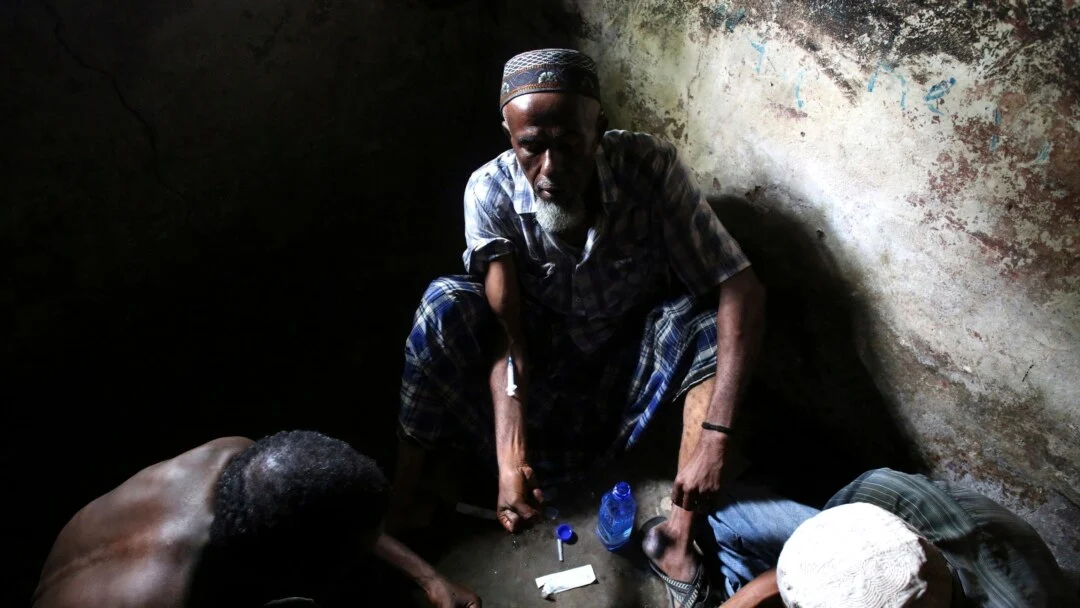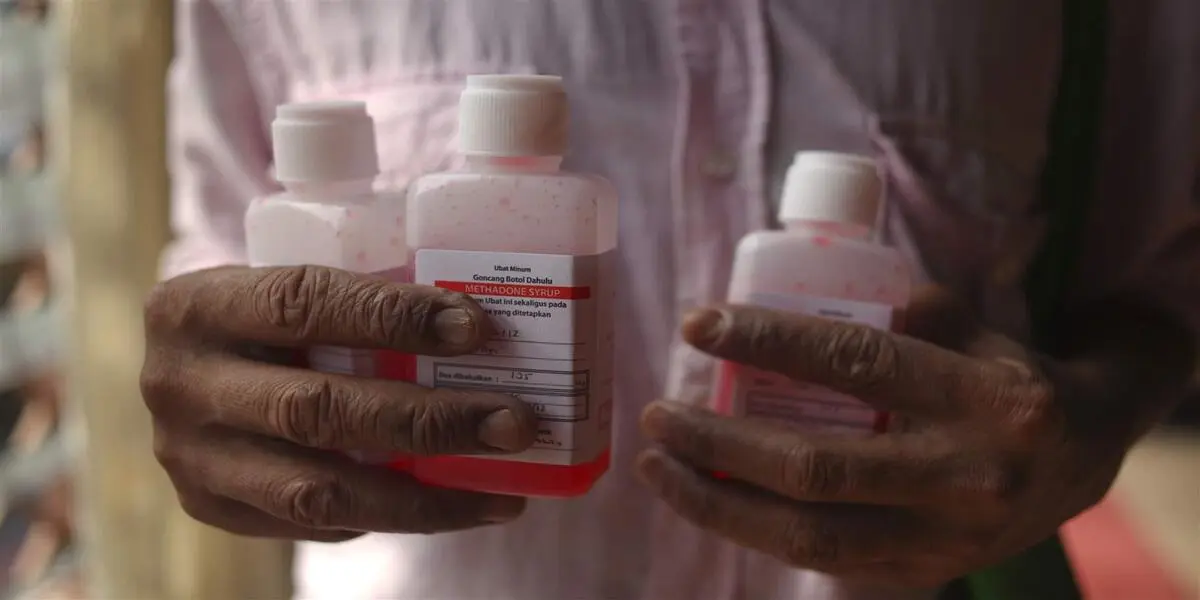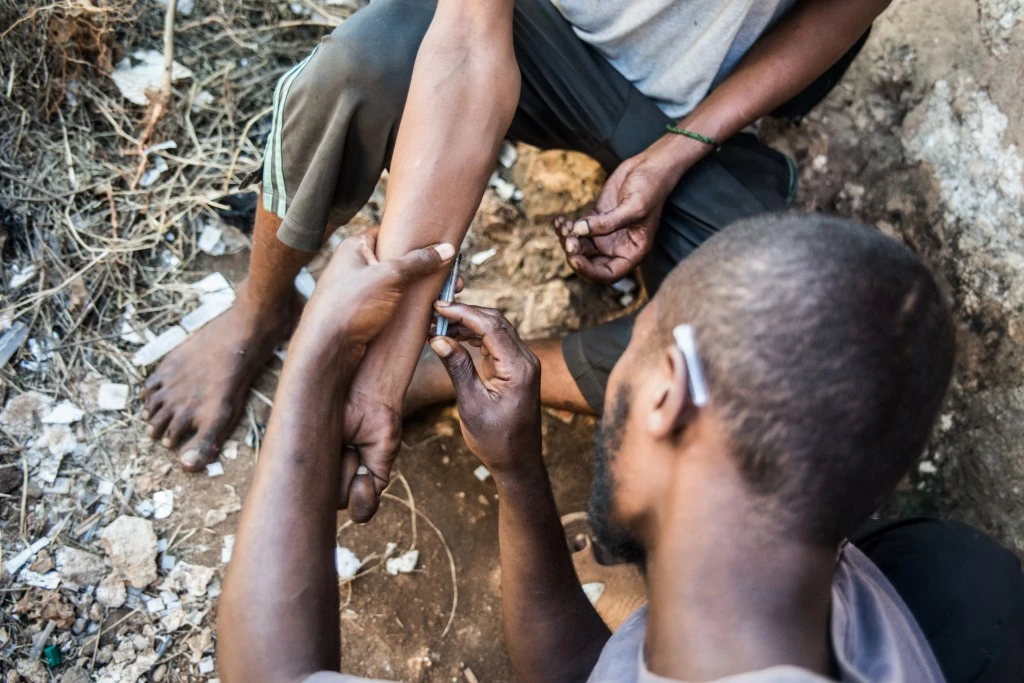Drug abuse has been decried as a major problem in the coastal region of Kenya. According to the 2022 National Household Survey on Substance Abuse (NHSISA) by the National Authority for the Campaign Against Alcohol and Drug Abuse (NACADA), Mombasa County has the highest rate of drug abuse in Kenya. The survey revealed that 25% of young people aged 15-24 in Mombasa use drugs, significantly higher than the national average of 6%. The most frequently abused substances in Mombasa County are heroin, cocaine, and bhang (cannabis).
Omari, a resident of Kisauni, Mombasa County, has borne the brunt of drug abuse, specifically heroin. “I began using the drug six years ago,” the 23-year-old began when we caught up with him and his gang at Mkomani Beach. Recently released from Shimo la Tewa Prison after serving a six-month stint on a possession charge, Omari allowed us to have a conversation with him about his dependence on the drug.
Drug abuse in this region is a major factor contributing to crime, violence, and the spread of HIV/AIDS. Additionally, a 2022 report by the United Nations Office on Drugs and Crime (UNODC) identified Mombasa County as a key transit hub for drug trafficking in East Africa. Furthermore, a 2021 report by Human Rights Watch (HRW) highlighted that drug abuse is a significant human rights issue in the county.
“Initially, it was just a quick fix with friends. When I dropped out of school and began working as a tout plying the Bamburi Mtambo-Town route, I had money and could afford little luxuries as I had no responsibilities weighing me down.” Omari said with a faraway look, staring across the strait to Fort Jesus and the Old Town beyond. What began as a quick fix eventually morphed into full dependence on the drug, whose high typically lasts 15 to 30 minutes.

Trying to grasp a fleeting high, felt like chasing wisps of cloud that couldn’t be contained. After some time, he couldn’t hold down his job. “Whenever I take the drug, I feel relaxed and unnatural pleasure,” he went on, smiling through discolored teeth.
While experiencing the effects of a heroin high, an individual undergoes changes in brain function, causing alterations in mood and perception. When heroin enters the brain, it is converted into morphine, which binds to the opioid receptors in the central nervous system. This binding results in a significant release of dopamine, producing intense euphoria and pleasure far exceeding that from natural stimuli.
The euphoric rush and other pleasurable effects of heroin are short-lived. However, during the high, heroin intoxication can lead to extreme drowsiness, causing the person to slip in and out of consciousness, a state often referred to as “nodding off.” The initial high is characterized by intense euphoria and a heightened sense of pleasure. As the high progresses and afterward, heroin intoxication can induce drowsiness, nodding off, mental sluggishness, slow or slurred speech, and confusion. Users may also experience feelings of warmth, relaxation, and coziness.
Over time, the pleasurable effects of a heroin high diminish as tolerance builds. Eventually, individuals may continue using heroin primarily to avoid withdrawal symptoms rather than to achieve the high. That is the fate of Omari and his gang.

“When I got arrested for possession, I couldn’t afford the fine and had to do time. It was tough in prison, the withdrawal was terrible and there were moments when my body completely shut down from weakness and I couldn’t function. I was vomiting, food had no taste and I’d be itching all over.” He showed me his skin, his arms, neck, and stomach were full of scabs.
“Eventually, I was taken to the welfare office where I met a doctor and counsellor. The doctor prescribed methadone to me and it was able to reduce the withdrawal symptoms and help me cope. Thereby living a semblance of normality.” He said.
Methadone stays active in the body much longer than heroin, with its effects lasting around 24 hours and peaking 4 to 8 hours after administration. Consequently, only a single daily dose is required, helping individuals maintain stability and make positive life changes. Methadone use also diminishes risky behaviours such as injecting drugs and is significantly more affordable than purchasing heroin or other illicit opioids.
Treatment with methadone can be long-term, lasting months or years to mitigate the dangers of illicit drug use, or short-term, spanning two weeks or less to facilitate safe withdrawal from heroin. Typically consumed as a syrup, methadone is also available in injectable and tablet forms, with the latter being more common for pain relief prescriptions.

However, in the case of Omari, he never went on with his treatment once he came out of prison. Instead, he resorted back to abusing heroin. This can mostly be attributed to a lack of support and professional follow-up by the relevant authorities to ensure addicts in the program do not drop out even after a change of circumstances like in the case of Omari. His pharmacotherapy ended when he left prison.
The common pharmacotherapy is Methadone and Suboxone treatments. Methadone and buprenorphine maintenance treatments offer several benefits for individuals dependent on heroin. These treatments significantly reduce the risk of contracting blood-borne viruses like hepatitis and HIV, along with other health hazards linked to injecting drugs. They also lower the likelihood of overdose.

Unlike illicit drugs, methadone and buprenorphine are produced under stringent controls, ensuring consistent strength and the absence of harmful fillers. While heroin’s effects are short-lived, lasting only a few hours, these pharmacotherapy treatments can stabilize a person for 24 hours or more, especially with long-acting injectable buprenorphine.
This stabilization alleviates the constant worry about sourcing heroin, reducing anxiety and allowing individuals to focus on self-care, including improving their health, nutrition, relationships, and employment status. Additionally, these treatments are more cost-effective than heroin, freeing up financial resources for other needs.
Across the coastal region, there are several centers of treatment from which individuals can seek help with addiction. These centres include Mewa Drop-in Centre in Mla Leo, Taita Taveta Christian Treatment & Rehabilitation Centre, Teens Watch Centre in Kwale, Eden House in Likoni, Reach Out Drug Treatment Centre in Mombasa, Reach Out Drop-in Centre in Mombasa, Kenya Red Cross Society Lamu Rehabilitation Center in Lamu, Amescosa Treatment and Rehabilitation Centre (Female Treatment Program) in Kilifi, New Leaf Centre in Lamu, and RiMa Serene Medical Centre in Mombasa.
To participate in the program, you must consult a doctor authorized to prescribe opioid pharmacotherapy treatment and attend regular check-ups where your dose will be monitored, and urine tests for methadone and other drugs may be conducted.
You need to visit your local pharmacist or dispenser daily for your dose, although those on long-acting buprenorphine only need to attend weekly or monthly. It may take a few weeks to determine your correct dose. Additionally, while seeing a counselor might be optional, research indicates that engaging in comprehensive treatment, including counseling, significantly enhances the likelihood of success in pharmacotherapy treatment.
















